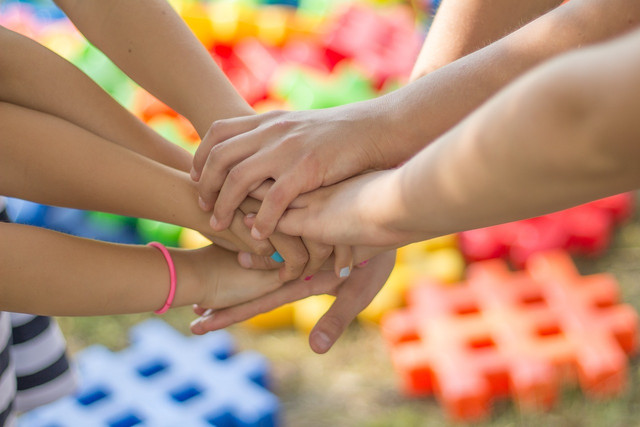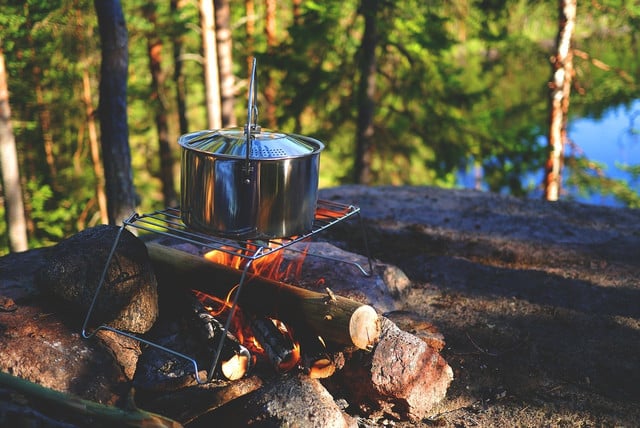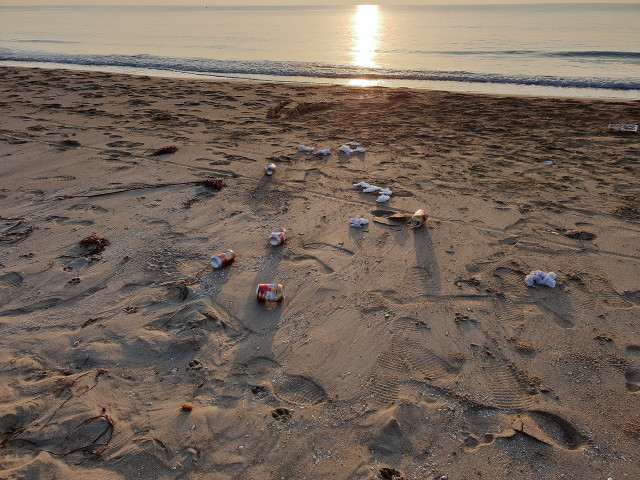Outdoor team-building activities give groups a chance to bond while solving problems together and getting to know each other. Check out our activities for the whole team.
Outdoor team-building activities give colleagues from the same or different departments the chance to interact with those they may not usually work with, improving communication and working relationships, while having fun and getting some fresh air. There are a huge array of team-building activities that can be done outdoors ranging from problem-solving, treasure hunting, team sports, and environmental or community activities. These activities can be done in the park, on a sports field, or somewhere further from the office like a forest or outward-bound area.
Outdoor team building aims to be inclusive for all team members, so the physical abilities of each participant should be taken into account, with adaptations made to the activities where necessary. After outdoor team-building activities are completed it is fun to wind down together as a team by having a more informal activity together such as a picnic or barbecue.
We’ll outline 25 outdoor team-building activities for group bonding, which can be adapted to suit any team or ability level.
Outdoor Problem Solving Activities

These short problem-solving activities can be set up anywhere, only require some simple equipment, and go well together. The activities can be adapted to suit all abilities.
- Nightline: This activity involves setting up an obstacle course that has a continuous rope running through it. All participants are blindfolded and hold the rope with their right hand and the shoulder of the person in front of them with their left. The aim of the task is for the team member in front to feel their way along the course and give guidance to those behind about what is coming up for them to step over, crawl through, etc. The assault course can be made up of planks of wood to walk over, some old tires to step through or even a kids climbing frame to step over. There needs to be one team member or course leader who is not blindfolded to ensure the safety of the team.
- Tower building: Give each team an equal amount of old newspapers and a roll of biodegradable packing tape (available on Amazon**) and some scissors. Each team has to try to build the tallest freestanding tower in a specified period (for example ten minutes), for an added challenge, an item can be placed on the top of the tower such as a ping pong ball or something heavier and the winning team is the one who can hold the item for the longest.
- Cardboard boat building: This activity needs to be done near a body of water such as a pond or lake. Each team is given an equal amount of old cardboard boxes, already broken down, and a roll of biodegradable packing tape. They have to construct a functional boat that will float across the water, perhaps with an item in it such as a doll. Depending on risk assessments and safety, the challenge could be to build a cardboard boat that is strong enough to hold a team member, there could then be a race to the other side of the water. Just be aware that wet cardboard can’t be recycled.
- Time bomb: An item (the bomb) is placed inside a cordoned-off area, for example, an old water bottle filled with sand, placed in a circle of rope (around six feet in diameter) on the floor. Each team is given some long lengths of rope and a specified length of time to try to pick up the bomb and take it out of the circle, without any team member entering the circle.
- Shelter building: In a forested area, find a large tree and place large fallen branches against it to form an upside-down “v” shape. Depending on the season, you could cover the outside with dried leaves or add features using rocks. An extra challenge could be to waterproof the shelter, and test it with the team members inside! Make sure shelters are taken down when finished.
- Volcano eruption: Give each team a few large pieces of old cardboard. Pretend a volcano is erupting and the floor is lava, each team has to get to the other side of the outdoor area by using the card as stepping stones and not falling into the lava. A referee can make things more difficult by removing some pieces of card so there is not one per person and team members have to support each other to not fall into the lava.
- Mine field: “Mines” such as sports balls are placed randomly on the ground. Team members pair up and one of them is blindfolded. They have to be guided through the minefield using verbal commands only from their partner, who stands on the side until they get to the other side. If they touch a mine they don’t win a point. This activity should be done in flat areas such as parks or playgrounds.
Creative Outdoor Team Building Activities



These activities are more creative than problem-solving focused but could be combined with the above problem-solving activities for a blend of group bonding opportunities.
- Party games: Some classic party games are good for team building, such as charades, where one team member has to act out a word such as the name of a movie or an item in the home, they cannot speak, and the rest of their team has to guess the word. A more laid-back version is where a team member draws a representation of the word on a whiteboard and the team members guess the word from their drawing. Both of these games provide lots of laughter at the team’s acting and drawing skills!
- Environmental art: This is especially fun in the autumn when the leaves on the ground are colorful. Use fallen leaves, rocks, or dried grass to make an outdoor collage. Make a frame on the ground using twigs and create a picture or pattern inside it. To stay as environmentally neutral as possible, don’t pull any living leaves from trees! You could also try making a rock sculpture by creatively stacking differently-shaped stones onto one another.
- Campfire cooking: Cooking is a fun way to bring people together. To make this into an outdoor activity the cooking could be carried out on a campfire, in a safely prepared area. All you need are some bricks to make a fire pit and some dry wood. Make sure you follow safety procedures and know how to put out a fire safely. Different team members could be responsible for different things such as starting the fire, chopping the vegetables, collecting wood, etc. Follow our campfire pizza recipe for something simple, vegan, and tasty, and check out these 15 easy vegetarian camping meals.
- Outdoor crafts: Nature can be used to make outdoor arts and crafts, these could be done on a large scale as teams and would work well in areas with trees and fallen leaves on the ground. For example, making sculptures using natural clay, painting on trees with dirt, making a leaf mobile, or drawing with charcoal, check out these 10 camping crafts for adults.
Outdoor Team Building for the Community



Outdoor team building can be beneficial to the community as well as the team itself, groups can bond whilst doing something to improve their neighborhood or help others.
- Tree planting: This activity enables the group to do something for the environment, as well as improve communication skills between team members. It needs to be organized, with trees being planted in an area where they’re needed — there are reforestation organizations, such as One Tree Planted that can assist in giving guidance about where trees need to be planted in your local area. Learn more about reforestation.
- Beach clean up: Participants can split into teams and collect trash along different parts of the beach, recycling anything that can be and disposing of other waste correctly. This could even be turned into an art from trash project, with teams using what they’ve found to make some recycled art.
- Donate to a food bank: Team members can each donate necessities such as canned food, diapers, and hygiene products. These can be collected and sorted by teams into care packages which can be donated to a local food bank or shelter.
- Practical conservation: Join a local environmental organization, such as American conservation experience to assist in invasive species removal using hand tools like bow saws and slashers, this could be along a local river, or in a small woodland to encourage wildflower growth.
- Neighborhood clean up: Bring the team to the local park or play area and clean up litter, remove graffiti, and repair damaged benches or park equipment. This could be done with permission from the local government or council and could even involve tree or flower planting.
- Build a bird box or bug hotel: Give birds a helping hand by providing them with a comfortable, warm bird box where they can build their nests and safely raise their young. Teams can work on the best decoration, with the winning team getting a prize. The finished bird boxes could be placed on the company grounds or even donated to a local school. For sizes and measurements, check out how to make a bird box with customizations or our guide on bug hotels.
Energetic Outdoor Team Building Activities



These activities are more active and energetic and may not be suitable for all participants, however, those less physically able may be able to take part by being a referee, time, or point keeper.
- Scavenger hunt: Go on a scavenger hunt around the park, forest or even across the city. Prepare a list of natural things to find, such as a brown leaf, a weed, a smooth rock, a cloud, a feather, a seed, three sticks, or a blade of grass. Each team has to check the items off their list, and the first to collect them all wins.
- Volleyball: This can be played on the beach or a grassy area, bring a net or make your own using some poles and a piece of long material. It may be wise to choose a softer ball than a real volleyball, even an inflatable beach ball which is lightweight. Winning teams can play each other until a final winner is declared.
- Orienteering: Teams can hike a local trail together and use a map and compass to find their way to a final destination point. Teams start at different locations and the team to get to the destination first is the winner. This activity will encourage problem-solving and leadership skills as well as morale-building between team members.
- Sports day: Teams take part in a range of fun, short races such as an egg and spoon race, sack race, long jump, relay race, and boot toss. The activities can be set up as a circuit in a park or on a sports field.
- Dodgeball: Another game that can be adapted to suit all levels by using a softer ball or a beach ball. There are three or more players on each team and the aim is to throw the ball at an opponent and if they get hit, you get a point. A player sits out if they get hit by the ball.
- Capture the flag: Each team has a flag located in their area, the opposing team has to try to catch the opposing team’s flag without getting tagged by the opposition. If someone gets caught they have to go to “jail”.
- Frisbee golf: Similar to how regular golf is played, the only equipment is a frisbee per team. Players take turns throwing the frisbee toward a target, (such as a flag or piece of material on the ground). The number of throws is recorded, with the lower number the better. This could be played on the beach, on a sports field, or at the park.
- Wildlife safari: Go to a local forest, lake, pond, or park and see what wildlife and evidence of wildlife you can find. Start small, with the bees and butterflies — notice what plants they’re attracted to, they are the pollinators of the world. Next, take the time to be silent and listen to the birds — you could even download an app to identify individual species, or make some homemade suet bird food and put it on a bird table or press it into a pine cone and hang it from a tree and count how many different birds come to it. By the way, bread is bad for birds and there are better options on what to feed them. If there is a pond or water feature you may be able to notice dragonflies hovering above it, or see some frogs or frogspawn, depending on the time of year. Teams could also go on safari and look for evidence of large mammals such as footprints, droppings, and fur.
Read more:
- 6 Tips for Setting Boundaries at Work
- The 9 Best Eco-Friendly Summer Activities For Adults
- The Guide to Effective Communication in the Workplace
Do you like this post?










